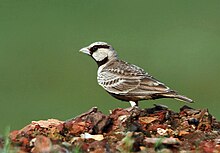Ashy-crowned sparrow-lark
| Ashy-crowned sparrow-lark | |
|---|---|
 |
|
| Male ashy-crowned sparrow-lark | |
| Scientific classification | |
| Kingdom: | Animalia |
| Phylum: | Chordata |
| Class: | Aves |
| Order: | Passeriformes |
| Family: | Alaudidae |
| Genus: | Eremopterix |
| Species: | E. griseus |
| Binomial name | |
|
Eremopterix griseus (Scopoli, 1786) |
|
| Synonyms | |
|
|
The ashy-crowned sparrow-lark (Eremopterix griseus) is a small sparrow-sized member of the lark family. It is found in the plains in open land with bare ground, grass and scrub across South Asia. The males are well marked with a contrasting black-and-white face pattern, while females are sandy brown, looking similar to a female sparrow. Males are easily detected during the breeding season by the long descending whistle that accompanies their undulating and dive-bombing flight displays.
The ashy-crowned sparrow-lark was originally placed in the genus Alauda. This species is also known by the following alternate names: ash-crowned sparrow-lark, ashy-crowned finch-lark, black-bellied finch-lark, and black-bellied sparrow-lark.
Although some subspecies ceylonensis (from Sri Lanka) and siccata (from Gujarat) have been named, variations are mostly clinal and they are treated as a monotypic species.
Sparrow sized with a finch-like bill and short legs, these birds are usually seen sitting on the ground, and although they will sometimes perch on wires they do not perch in trees or bushes. The male is sandy brown overall with a black belly, chin, lower lores and eye stripe. The top of the head is ashy (although the base of these crown feathers are dark) unlike the dark brown to black in the black-crowned sparrow-lark which partly overlaps with the range of this species in the arid zone of India and Pakistan. The female is pale brown and very similar to a female house sparrow, although the legs are much shorter and appearing stockier and shorter-necked.
This species is restricted to below 1000 metres elevation and is found from south of the Himalayas to Sri Lanka extending to the Indus river system in the west and to Assam in the east. It is found in stubble, scrub, waste land, riverside sand and tidal flats on the coast. They avoid the interior of the desert zone, a habitat that is more likely to be used by the black-crowned sparrow-lark. The two species overlap partly in range, although they are rarely seen together in the same locations. During the monsoon season, they withdraw from heavy rainfall regions.
These larks are found in pairs or small groups and form larger flocks in winter. They forage on the ground for seeds and insects. When disturbed they will sometimes crouch and take to flight. They will take fallen grain in fields. They roost at night on the ground, making small depressions in the soil.
...
Wikipedia

